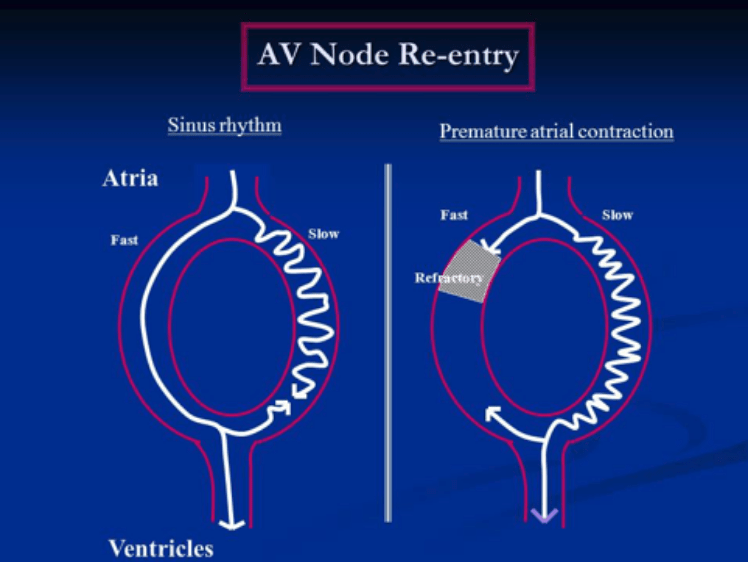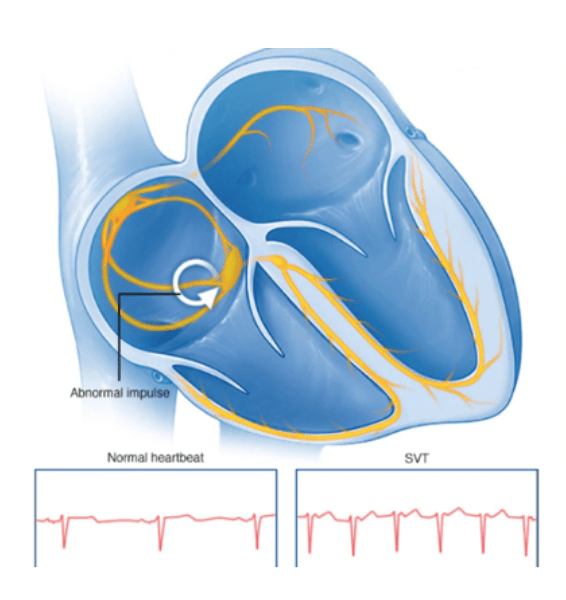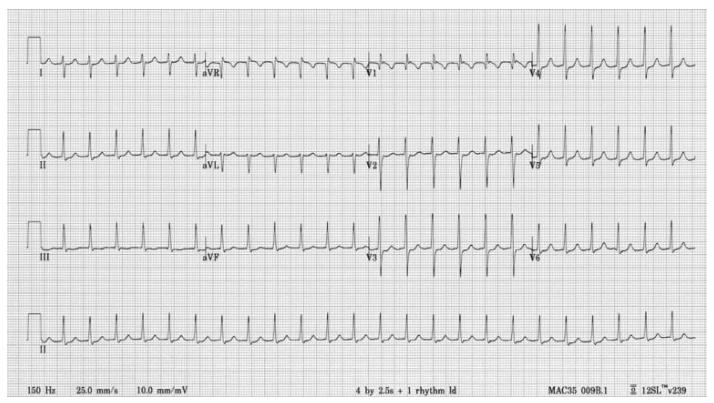About Atrioventricular Nodal Re-entrant Tachycardia
Atrioventricular nodal re-entrant tachycardia (AVNRT) is a common type of supraventricular tachycardia (SVT).
A supraventricular tachycardia refers to a heart rhythm that originates or starts within the upper chambers of the atria. It is characterised by an electrical abnormality within the atrioventricular node (AV), which is the bridge between the atrium and the ventricle.
This electrical pathway allows an electrical stimulus to travel via a slow and a fast pathway or circuit within the AV node. It can result in a rapid heart rate, often over 140 – 250 beats per minute.1


Prevalence of Atrioventricular Nodal Re-entrant Tachycardia
AVNRT is more prevalent in patients who are in their twenties, however, it has been reported in patients that are older as well. It is thought that up to 60% of paroxysmal supraventricular tachycardias may be an AVNRT in origin.
Signs and Symptoms of Atrioventricular Nodal Re-entrant Tachycardia
Most patients with AVNRT present with symptoms such as:
- Dizziness / presyncope,
- Palpitations,
- Shortness of breath,
- Anxiety related palpitations,
- Fluttering feeling in the throat and/or neck,
- Potential chest discomfort,
- Heart rates between 140 – 250 beats per minute,
- Hypotension (low blood pressure) due to rapid heart rates.
Symptoms may also be exacerbated by caffeine, tobacco, alcohol intake and can follow after exercise or due to significant emotional stressors that can precipitate an AVNRT episode.4
Diagnosis of Atrioventricular Nodal Re-entrant Tachycardia
Diagnosis of AVNRT is often made when physical symptoms present with the symptoms outlined above, although the condition is often confirmed on the examination of an Electrocardiograph (ECG). AVNRT presents on an ECG as a narrow complex tachycardia (rapid heart rate > 100 bpm). A typical AVNRT ECG may present as seen below.

Treatment Options of Atrioventricular Nodal Re-entrant Tachycardia
The treatment goal for AVNRT is to reduce the rapid heart rate to relieve symptoms and ultimately return to a more acceptable heart rate through a range of therapy options. Treatment may depend on the frequency of AVNRT episodes, the severity of symptoms as well as other medical conditions. A patients’ Cardiologist will discuss all treatment options available with the patient.
Medical Treatment
Patients with low blood pressure, high heart rates and altered levels of consciousness may require urgent medical care in an Emergency Department immediately.
- Vasovagal techniques aim to slow the bodies autonomic system by slowing the electrical conduction through the AV node, hopefully ending the rapid heart rate. There are multiple techniques used to perform this manoeuvre, which are only used after the patient has been assessed and deemed clinically stable (blood pressure normal).
Modified Valsalva manoeuvre for supraventricular tachycardia
*All content on Hope For Hearts does not endorse or promote any brands or devices and is only intended for educational purposes. Patients should always consult individual health matters with a medical professional.
- Medical treatment may include the administration of drugs that aim to slow the electrical conduction of the heart stimulus through the AV node, therefore breaking the “circuit”, and slowing the heart rate to an acceptable level.
- Some patients may be prescribed medications to take either when episodes occur again or longer-term, commonly described as a “pill in the pocket.”6
Procedural Treatment
For a more permanent definitive treatment, a Catheter Ablation procedure may be considered. In this procedure, a small catheter is inserted through a large vessel in the groin where an electrical catheter is placed within the heart.
The electrical “circuit” is then identified and using the alternate pathway is disrupted using radiofrequency heat or sometimes (depending on the location of the circuit) cryocatheter techniques.
This procedure is performed in a Hospitals’ Cardiac Catheter Laboratory by a Cardiologist, Electrophysiologist.
*All content on Hope For Hearts does not endorse or promote any brands or devices and is only intended for educational purposes. Patients should always consult individual health matters with a medical professional.
